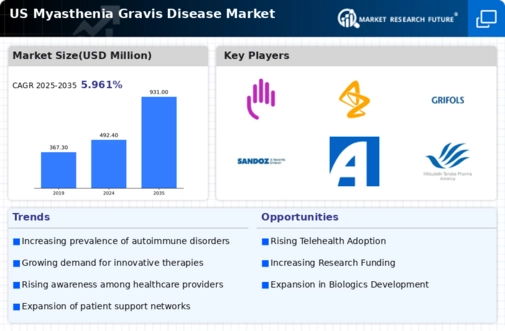Increased Research Funding
The myasthenia gravis-disease market is benefiting from increased research funding aimed at understanding and treating the condition. Government and private organizations are allocating substantial resources to research initiatives, which is likely to lead to the development of novel therapies and treatment modalities. For instance, funding for clinical trials and studies focused on myasthenia gravis has seen a notable rise, potentially resulting in innovative solutions that address unmet medical needs. This influx of financial support is expected to stimulate growth within the myasthenia gravis-disease market, as new therapies emerge and existing treatments are optimized. Additionally, collaboration between academic institutions and pharmaceutical companies may enhance the pace of research, further contributing to advancements in the field.
Growing Demand for Immunotherapy
The myasthenia gravis-disease market is witnessing a growing demand for immunotherapy as a treatment option. Immunotherapy has shown promise in managing autoimmune diseases, including myasthenia gravis, by modulating the immune response. As more patients and healthcare providers recognize the potential benefits of immunotherapy, the market for these treatments is likely to expand. Current estimates indicate that the immunotherapy segment could account for a substantial share of the myasthenia gravis-disease market in the coming years. This shift towards immunotherapy reflects a broader trend in the treatment of autoimmune disorders, where traditional therapies may not provide adequate relief. The increasing acceptance of immunotherapy is expected to drive innovation and investment in this area, ultimately benefiting patients.
Advancements in Diagnostic Techniques
The myasthenia gravis-disease market is significantly influenced by advancements in diagnostic techniques. Improved diagnostic tools, such as antibody testing and electrodiagnostic studies, have enhanced the ability to accurately identify myasthenia gravis. This has led to earlier diagnosis and intervention, which is crucial for effective management of the disease. The availability of precise diagnostic methods is likely to increase the number of patients seeking treatment, thereby expanding the myasthenia gravis-disease market. Moreover, as awareness of these advanced diagnostic options grows among healthcare professionals, it may lead to a higher rate of diagnosis and subsequent treatment initiation, further driving market growth. The integration of technology in diagnostics is expected to play a pivotal role in shaping the future landscape of the myasthenia gravis-disease market.
Regulatory Support for New Treatments
The myasthenia gravis-disease market is positively impacted by regulatory support for the approval of new treatments. Regulatory agencies in the US are increasingly streamlining the approval process for innovative therapies, which may facilitate quicker access to new treatment options for patients. This supportive regulatory environment is likely to encourage pharmaceutical companies to invest in the development of novel therapies targeting myasthenia gravis. As a result, the myasthenia gravis-disease market may experience accelerated growth, with more treatment options becoming available to patients. Furthermore, the emphasis on expedited review pathways for breakthrough therapies could lead to a more dynamic market landscape, ultimately enhancing patient outcomes and satisfaction.
Rising Incidence of Myasthenia Gravis
The myasthenia gravis-disease market is experiencing growth due to the rising incidence of the disease in the US. Recent estimates suggest that approximately 20 per 100,000 individuals are affected by myasthenia gravis, indicating a growing patient population. This increase in prevalence is likely to drive demand for effective treatment options and healthcare services. As more individuals are diagnosed, the need for specialized care and innovative therapies becomes paramount. The myasthenia gravis-disease market is thus positioned to expand, as healthcare providers seek to address the needs of this increasing patient demographic. Furthermore, the aging population, which is more susceptible to autoimmune disorders, contributes to the rising incidence, further emphasizing the need for advancements in treatment and management strategies.

















Leave a Comment